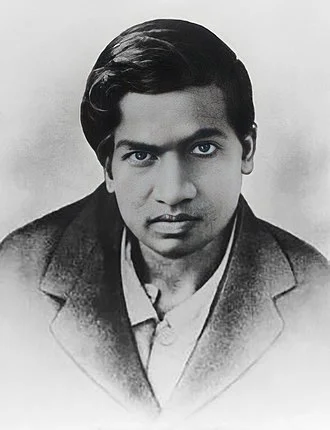Context: Every year, on December 22nd, the birth anniversary of legendary mathematician Srinivasa Ramanujan (1887-1920), is celebrated as National Mathematics Day.
- In 2012, then Prime Minister Manmohan Singh declared December 22 as National Mathematics Day in honor of the great man.
About Srinivasa Ramanujan
- Birth: He was born on 22nd December, 1887 in the town of Erode in Madras Presidency (now Tamil Nadu), to a Brahmin Iyengar family.
- Excelled in Mathematical Aptitude: By the age of 14, he was completing mathematics examinations in half the allotted time, and exploring complex topics way beyond the capability of an average 14-year old.

|
“The Man Who Knew Infinity”:
- His biography by Robert Kanigel depicts his life and journey to fame.
- A film of the same name was released in 2015 in which British-Indian actor Dev Patel played Ramanujan.
Must Read: National Mathematics Day 2023, here.
|
Srinivasa Ramanujan: A Chronology of his Achievements
- In 1904: After finishing secondary school, he received a scholarship at the Government Arts College, Kumbakonam.
- By 1910: He was gaining popularity in Madras’ mathematical circles.
- In 1911: He published the first of his papers in the Journal of the Indian Mathematical Society.
- In 1912: V Ramaswamy Iyer, founder of the Indian Mathematical Society, helped him get a clerical position at the Madras Port Trust.
- In 1913: Impressed with his’s theorems and work related to infinite series, the Cambridge-based GH Hardy called him to London.
- In 1914: He traveled to England and with Hardy’s help, got enrolled in Trinity College, Cambridge, where Hardy tutored him and collaborated with him in some research.
- In 1917: He was elected to be a member of the London Mathematical Society.
- In 1918: He was elected to the prestigious Royal Society for his research on Elliptic Functions and theory of numbers, becoming one of the youngest to ever achieve the feat.
- He was also the first Indian to be elected a Fellow of the Trinity College.
Ramanujan: His Major Contributions to Mathematics
- Infinite Series for pi: In 1914, Ramanujan found a formula for infinite series for pi. Finding an accurate approximation of π (pi) has been one of the most important challenges in the history of mathematics.
- Game Theory: His contribution to game theory is purely based on intuition and natural talent and is unmatched to this day.
- Mock Theta Function: He elaborated on the mock theta function, a concept in the field of modular forms of mathematics.
- Ramanujan Number: 1729 is known as the Ramanujan number which is the sum of the cubes of two numbers 10 and 9.
- Circle Method: Ramanujan, along with GH Hardy, invented the circle method which gave the first approximations of the partition of numbers beyond 200.
- This method contributed significantly to solving the notorious complex problems of the 20th century, such as Waring’s conjecture and other additional questions.
- Theta Function: It is a special function of several complex variables.
- German mathematician Carl Gustav Jacob Jacobi invented several closely related theta functions known as Jacobi theta functions.
- Theta function was studied extensively by Ramanujan who came up with the Ramanujan theta function, which is used to determine the critical dimensions in Bosonic string theory, superstring theory, and M-theory.
- His Significant Contributions: Mathematical fields such as complex analysis, number theory, infinite series, continued fractions, Riemann series, elliptic integrals, hypergeometric series, and the functional equations of the zeta function.
- He discovered his own theorems and independently compiled 3,900 results.
His Later Stage
- In 1919: Ramanujan returned to India from England.
- He spent his last year producing some of his most profound mathematics.
- In 1920: At just 32 years of age, he breathed his last owing to deteriorating health.
- After his death, Ramanujan left behind three notebooks and some pages containing unpublished results, on which mathematicians continued to work for many years.
News Source: The Indian Express
![]() 23 Dec 2023
23 Dec 2023

